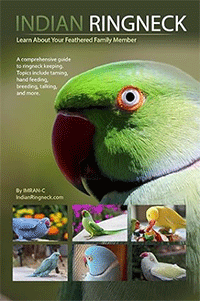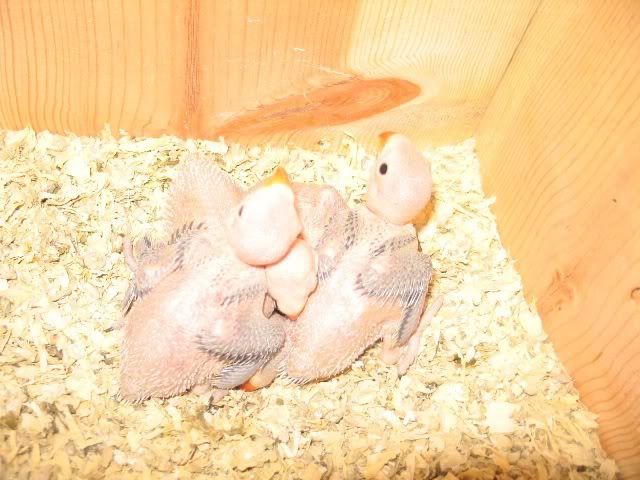? on breeding IRN's & why mom killing offspring
Moderator: Mods
? on breeding IRN's & why mom killing offspring
i have had a pair of IRN's for about 5 years, last year i had a clutch of about 4 eggs but only 1 was born and the rest were fertile but the female killed off the only baby that hatched and she left the nest so the other babys died in the egg's This season the same thing happended is it that she is not a good mom or something im doing wrong. 
I’m sorry for your loss. Unfortunately, things like this do happen as breeding IRNs is not so cut and dry. Birds are their own individuals and each has their own peculiarities.
How many chicks hatched this time around? Although it is possible for the parents to be purposely attacking their hatched chicks, there’s a bigger possibility they are merely neglecting to feed them.
Some birds, especially first time parents, do not always know what to do with a newborn baby. Newly-hatched chicks do not chirp a lot and aloud to attract the parents attention to feed them. Needless to say, it is very important for a new-hatch to be fed as its last meal of egg yolk or albumen will soon be depleted. These considered, it is very important to watch this particular pair vigilantly and catch the moment the chicks are hatched. It helps a lot if the nest box is mounted outside the cage so this is one of the reasons why I recommend that nest boxes be mounted outside the cage for ease with inspection (sometimes removal of excessive feces and dead chicks). It is equally as important to condition your pairs with you checking on their nest boxes often. Hens not used to this will scramble and trample on the chicks/eggs as soon as the nest box inspection doors are opened. Most of my hens will leave the nest box as soon as I gently knock on the box, and will scurry back in as soon as I leave and readily resume where they left off. The few who chose to remain in the box, like the picture below, will quietly and reluctantly ease into one corner while I inspect the eggs/chicks.
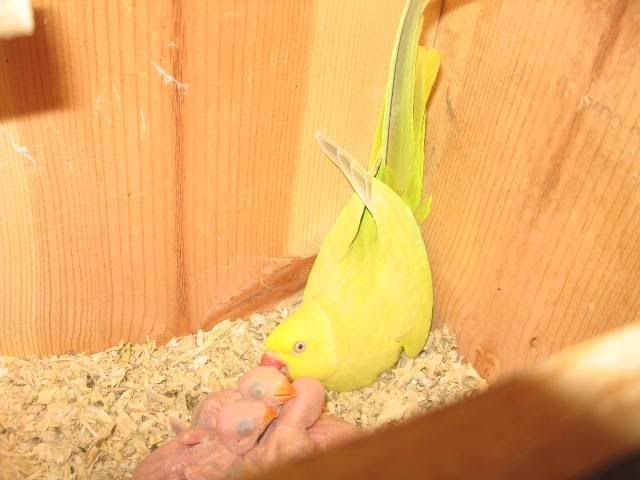
So back to your issue, a couple hours after hatching, inspect the crop of the chicks to check if they are full. This provides a very important clue if the parents are actually feeding them. If the crop is empty, give the parents another 2 hours and then check the crops again. If still empty, give the chicks a warm, watery-thin vegetable-based baby food using a syringe. Do this for a couple of days or so until the parents catch on and take over. It is imperative to NEVER allow the chicks to go unfed for over 6 hours after hatching and every 2 hours thereafter. Normally, the chicks start chirping on the evening of the first day so they can beg for food on their own. Hopefully the parent birds will get the idea. Continue inspecting the chicks until you are very sure the parents have caught on and taken over the feeding tasks.
When inspecting the chicks and you see any evidence of physical attack from the parents, pull the chicks from the nest box and you will need to hand-feed them yourself. Imran has a very informative article on hand-feeding day-old chicks on this article.
http://www.indianringneck.com/handfeed/
You may need to pair these birds to other mates next season to identify which one of the parents is attacking the chicks. Also, pairing to other birds may be an option for hens abandoning their unhatched fertile eggs as they may behave differently when paired to another.
Goodluck and hope that helps.
How many chicks hatched this time around? Although it is possible for the parents to be purposely attacking their hatched chicks, there’s a bigger possibility they are merely neglecting to feed them.
Some birds, especially first time parents, do not always know what to do with a newborn baby. Newly-hatched chicks do not chirp a lot and aloud to attract the parents attention to feed them. Needless to say, it is very important for a new-hatch to be fed as its last meal of egg yolk or albumen will soon be depleted. These considered, it is very important to watch this particular pair vigilantly and catch the moment the chicks are hatched. It helps a lot if the nest box is mounted outside the cage so this is one of the reasons why I recommend that nest boxes be mounted outside the cage for ease with inspection (sometimes removal of excessive feces and dead chicks). It is equally as important to condition your pairs with you checking on their nest boxes often. Hens not used to this will scramble and trample on the chicks/eggs as soon as the nest box inspection doors are opened. Most of my hens will leave the nest box as soon as I gently knock on the box, and will scurry back in as soon as I leave and readily resume where they left off. The few who chose to remain in the box, like the picture below, will quietly and reluctantly ease into one corner while I inspect the eggs/chicks.

So back to your issue, a couple hours after hatching, inspect the crop of the chicks to check if they are full. This provides a very important clue if the parents are actually feeding them. If the crop is empty, give the parents another 2 hours and then check the crops again. If still empty, give the chicks a warm, watery-thin vegetable-based baby food using a syringe. Do this for a couple of days or so until the parents catch on and take over. It is imperative to NEVER allow the chicks to go unfed for over 6 hours after hatching and every 2 hours thereafter. Normally, the chicks start chirping on the evening of the first day so they can beg for food on their own. Hopefully the parent birds will get the idea. Continue inspecting the chicks until you are very sure the parents have caught on and taken over the feeding tasks.
When inspecting the chicks and you see any evidence of physical attack from the parents, pull the chicks from the nest box and you will need to hand-feed them yourself. Imran has a very informative article on hand-feeding day-old chicks on this article.
http://www.indianringneck.com/handfeed/
You may need to pair these birds to other mates next season to identify which one of the parents is attacking the chicks. Also, pairing to other birds may be an option for hens abandoning their unhatched fertile eggs as they may behave differently when paired to another.
Goodluck and hope that helps.
I inspedcted them last seasson and the mother killed the offspring so this time i didnt even want to peek at the nest box until after about a month and a half when she laid the last egg's so if there were chicks they would be about 2-3 weeks old so i could hand feed but 2 days before inspecting i noticed that the hen didnt go back inside nest box so when i looked i found one dead baby and three unhatched eggs you could see the baby chicks inside but they didnt make it becasue she never went back inside the nest box the didnt hatched So will try to mate them both with different partners next seasson thank for the advice and the link 
ringneck wrote:wow, what a nice photo and great info.When did you take that?
Hey Imran,
That was taken three days ago. Here's one taken yesterday.
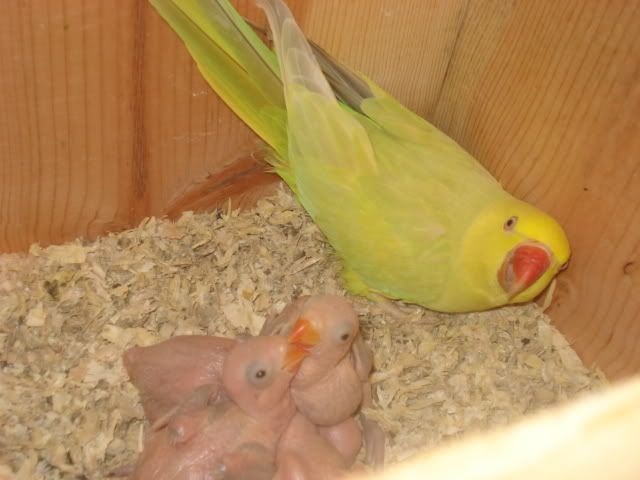
The mother is a Green Lacewing and the father is a Turquoise Lacewing. Some people call them Pallids nowadays but I find it odd calling such a beautiful mutation a morbidly-sounding name.
Here's the father nervously pacing on the perch while I inspect his family.
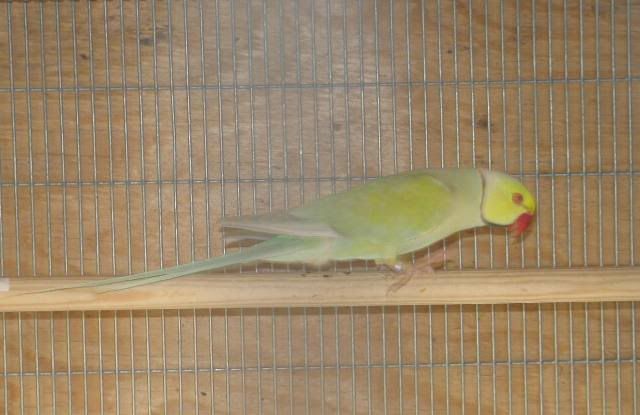
I plan on pulling the chicks next weekend for hand-feeding along with their next-door neighbor, a Blue Lacewing x Turquoise PallidIno brood.
nitro4lf wrote:I inspedcted them last seasson and the mother killed the offspring so this time i didnt even want to peek at the nest box until after about a month and a half when she laid the last egg's so if there were chicks they would be about 2-3 weeks old so i could hand feed but 2 days before inspecting i noticed that the hen didnt go back inside nest box so when i looked i found one dead baby and three unhatched eggs you could see the baby chicks inside but they didnt make it becasue she never went back inside the nest box the didnt hatched So will try to mate them both with different partners next seasson thank for the advice and the link
This is where I sometimes differ with other breeders. Some of them recommend not even looking inside the nestbox after candling and just leave everything to nature. I believe regular inspection gives you the opportunity to catch nestling irregularities and correct them (splayed legs, unfed chicks, etc). Removal of dead siblings, feces, unhatched eggs and eggshells is also important as they pose possible health hazards to the surviving chicks.
It may still be okay to find another mate this season. I've had pairs that laid eggs as late as May. It may be worth the shot.
depois do prazer,
depois do prazer I must agree with you. Regular inspection is key to catching birth and hatching problems. My female Ringnecks are used to me inspecting their eggs and nest and most just move over while I candle and inspect the chicks.
In my opinion, it’s a good thing to condition the mother to be used to human inspection.
Best Wishes,
Imran Chaudhry
P.S. please post more photos of your babies...can't wait to see them!
depois do prazer I must agree with you. Regular inspection is key to catching birth and hatching problems. My female Ringnecks are used to me inspecting their eggs and nest and most just move over while I candle and inspect the chicks.
In my opinion, it’s a good thing to condition the mother to be used to human inspection.
Best Wishes,
Imran Chaudhry
P.S. please post more photos of your babies...can't wait to see them!
